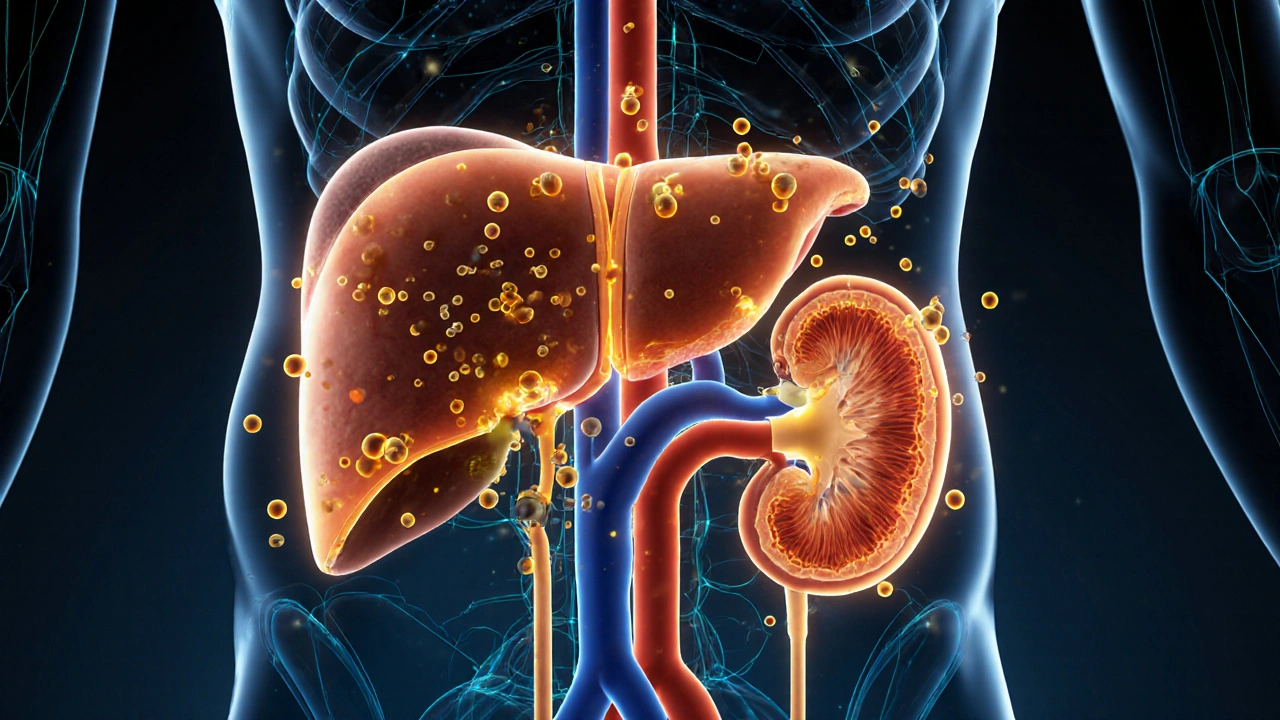
ACV Dosage Calculator
Personalized ACV Dosage Calculator
Determine the right ACV dosage for you based on your experience level and health considerations.
How to Use ACV Safely
Always dilute ACV - Never drink it undiluted. Use 1-2 tsp per 8 oz of water.
Use a straw - Minimize contact with teeth to prevent enamel erosion.
Take with food - Reduces stomach irritation.
Start small - Begin with 1 tsp and gradually increase.
Everyone’s asked, "Does apple cider vinegar help detox?" The hype around ACV (apple cider vinegar) is huge, and the answer isn’t a simple yes or no. In this guide we’ll unpack what detox actually means, which compounds in ACV might influence the process, what the research says, safe ways to try it, and how it stacks up against other popular detox drinks.
What Does “Detox” Really Mean?
Detox, short for detoxification, is the body’s natural method of clearing waste. Your Liver the primary organ that filters toxins from blood, metabolizes drugs, and breaks down chemicals and Kidneys filter blood to remove soluble waste via urine work around the clock to keep you clean. When people talk about detox diets or drinks, they usually mean supporting these organs with nutrients that may enhance their efficiency.
How Apple Cider Vinegar Is Made
Traditional Apple Cider Vinegar a fermented product made from crushed apples, sugar, and yeast that converts sugar into alcohol and then into acetic acid starts with crushed apples that are sweetened and left to ferment. Yeast turns the sugars into alcohol, then bacteria (Acetobacter) convert the alcohol into Acetic Acid the main active component of vinegar, typically 5-6% in ACV, responsible for its sour taste and antimicrobial properties. The finished product also contains trace amounts of Probiotics live beneficial bacteria that can help balance gut flora, vitamins, and minerals from the apples.
Key Components That Could Influence Detox
- Acetic Acid - lowers blood sugar after meals, may improve insulin sensitivity, and has been shown to increase the activity of enzymes involved in fat metabolism.
- Probiotics - help maintain a healthy Gut Microbiome the community of microorganisms living in the digestive tract, which plays a role in immune function and toxin breakdown.
- Polyphenols - antioxidant compounds that can neutralize free radicals and may protect liver cells from oxidative stress.
- Potassium - a mineral that supports cellular function and may help maintain proper fluid balance during detox routines.
None of these ingredients magically “flush” toxins, but they can support the organs that naturally do the work.

What Science Says About ACV and Detox
Research on ACV’s detox potential is limited, but a few studies shine some light:
- Blood Sugar Control: A 2004 clinical trial showed that taking 2g of acetic acid (about 1tablespoon of ACV) with a high‑carb meal reduced post‑meal glucose spikes by 20%.
- Weight Management: A 2018 pilot study found that participants who added ACV to a calorie‑restricted diet lost slightly more weight, likely due to improved satiety and reduced insulin spikes.
- Liver Enzyme Activity: Animal research indicates that acetic acid can boost the activity of hepatic enzymes that process fatty acids, suggesting a modest support for liver detox pathways.
- Gut Health: Small human trials of probiotic‑rich unfiltered ACV reported modest improvements in bloating and bowel regularity, hinting at a healthier gut microbiome.
None of these studies prove that ACV directly eliminates toxins, but they do show that its components can aid the body’s own detox systems.
Practical Ways to Use ACV for Detox
If you want to experiment, keep these guidelines in mind:
- Start Small: Dilute 1 teaspoon of raw, unfiltered ACV in 8oz of water. Drink it before a meal once a day for a week.
- Increase Gradually: If you tolerate it well, move up to 1-2tablespoons per day, split into two doses (morning and evening).
- Combine with Food: Adding a splash of ACV to salads, smoothies, or soups reduces the risk of stomach irritation.
- Pair with Fiber: Pairing ACV with high‑fiber meals (e.g., oats, beans, vegetables) can enhance satiety and support gut motility.
- Stay Hydrated: ACV is acidic; drinking extra water throughout the day helps protect tooth enamel and keeps kidneys happy.
Remember, the goal isn’t a miracle cleanse-it’s to give your liver, kidneys, and gut a gentle boost.
Potential Risks and Who Should Avoid It
While ACV is generally safe for most people, it isn’t risk‑free:
- Tooth Enamel Erosion: The acidity can wear down enamel. Use a straw or rinse your mouth afterward.
- Digestive Discomfort: Large doses may cause nausea or heartburn, especially on an empty stomach.
- Medication Interactions: ACV can lower potassium levels and affect insulin, so people on diuretics, potassium‑saving meds, or diabetes drugs should consult a doctor.
- Pregnancy & Breastfeeding: No strong evidence of harm, but moderate amounts (1tsp diluted) are advised.
If you have chronic kidney disease, peptic ulcers, or a history of low potassium, skip the daily ACV regimen.

Comparing ACV with Other Popular Detox Drinks
| Drink | Main Active Ingredient | Reported Benefits | Typical Dosage | Potential Side Effects |
|---|---|---|---|---|
| Apple Cider Vinegar fermented apple juice rich in acetic acid | Acetic Acid | Blood‑sugar moderation, mild appetite control, gut‑microbiome support | 1‑2 tsp diluted in water daily | Tooth enamel wear, stomach upset if taken undiluted |
| Lemon Water | Vitamin C + Citric Acid | Hydration boost, antioxidant intake, mild alkalizing effect | Juice of ½ lemon in 8 oz water each morning | Dental erosion if sipped continuously |
| Green Tea | Epigallocatechin Gallate (EGCG) | Metabolism support, antioxidant protection, mild diuretic | 2-3 cups per day | Insomnia if consumed late, caffeine‑related jitter |
| Dandelion Root Tea | Taraxasterol & Inulin | Natural diuretic, liver‑protective flavonoids, digestive aid | 1 cup brewed, 2-3 times daily | Allergic reactions in sensitive individuals |
Each drink offers a different angle. If your main goal is apple cider vinegar detox support-especially blood‑sugar stability and gut health-ACV edges out the others, but it’s not a cure‑all.
Bottom Line: Does ACV Help Detox?
Answering the headline question: ACV doesn’t magically flush chemicals out of your system, but its Acetic Acid supports metabolic pathways that can improve how the liver processes fats and sugars, and its probiotics can nurture a healthier gut microbiome. When used in moderation, diluted ACV can be a useful addition to a balanced diet that already includes plenty of water, fiber, and whole foods.
Think of ACV as a small helper rather than a stand‑alone detox solution. Pair it with sensible eating, regular movement, and adequate sleep, and you’ll give your body the best chance to clear out waste naturally.
Frequently Asked Questions
Can I drink apple cider vinegar on an empty stomach?
It’s best to dilute it in water and have it with or after a small meal. Drinking it straight can irritate the stomach lining and increase acidity.
How much ACV should I consume for detox benefits?
Start with 1teaspoon (5ml) diluted in 8oz of water once daily. If tolerated, you can increase to 1-2tablespoons spread across the day.
Is raw, unfiltered ACV better than filtered?
Raw, unfiltered ACV contains the “mother”-a colony of beneficial bacteria and enzymes-so it offers extra probiotic benefits compared to filtered versions.
Will ACV interact with my diabetes medication?
Because ACV can lower blood‑sugar levels, it might enhance the effect of insulin or oral hypoglycemics. Talk to your doctor before adding it to your regimen.
Can ACV replace a full detox cleanse?
No. ACV supports existing detox pathways but does not substitute for a balanced diet, adequate hydration, and overall healthy lifestyle habits.


6 Comments
Thank you for presenting a comprehensive overview of apple cider vinegar; the information is both thorough and balanced, and it offers practical guidance for readers who are curious about incorporating ACV into their routines. It is commendable that the article emphasizes dilution, the importance of consulting healthcare professionals, and the potential interactions with medications. Moreover, the inclusion of a dosage calculator adds a valuable interactive element, allowing individuals to personalize their approach based on experience level and health conditions. The discussion about the biochemical components-acetic acid, probiotics, polyphenols, and potassium-provides a solid scientific foundation. Overall, the piece successfully demystifies common myths while highlighting realistic benefits.
Wow, ACV is the miracle cure for everything, right?
Really solid piece, I appreciate the no‑nonsense tone. The way you break down the science into bite‑size chunks is helpful. I also like the reminder to watch out for tooth enamel – that’s something a lot of folks forget.
Great read! It’s refreshing to see a balanced take that neither demonizes nor glorifies ACV. The practical tips about using a straw and pairing it with meals are spot‑on, especially for those with sensitive stomachs. Keep up the good work!
One might contemplate the broader philosophical implication of seeking a quick “detox” fix. In a world where chronic stress and processed foods dominate, the allure of a simple tonic is understandable, yet it also reflects a deeper yearning for control over one’s internal ecosystem. By integrating ACV thoughtfully, we engage with the idea that small, consistent habits can echo larger transformations.
Apple cider vinegar can be a useful adjunct to a healthy lifestyle, but it’s important to set realistic expectations. First, the acetic acid content has been shown in some studies to modestly improve post‑prandial glucose levels, which can be beneficial for individuals monitoring blood sugar. Second, the probiotic "mother" present in raw, unfiltered varieties may support gut microbiota diversity, though the effect size is modest compared to dedicated fermented foods.
Third, the polyphenols in apples contribute antioxidant activity that can protect liver cells from oxidative stress, yet this protection should not be confused with a direct detoxifying agent.
When incorporating ACV, start with one teaspoon diluted in eight ounces of water; this minimizes the risk of enamel erosion and gastrointestinal discomfort. Using a straw can further protect dental enamel, a tip often overlooked in popular articles.
A gradual increase to one or two tablespoons per day is reasonable for those who tolerate the initial dose well, but always listen to your body and discontinue if you experience irritation.
Pair ACV with high‑fiber meals-such as oatmeal, legumes, or vegetables-to enhance satiety and promote regular bowel movements. Fiber also acts as a substrate for beneficial gut bacteria, amplifying any probiotic benefit from the vinegar.
Hydration is key: the acidic nature of ACV can place additional demand on the kidneys, so adequate water intake supports renal function and helps flush metabolic waste.
For individuals on diuretics, potassium‑sparing medications, or insulin therapy, consulting a healthcare provider before starting is crucial, as ACV can influence electrolyte balance and glycemic control.
In summary, ACV is not a magic detox potion, but it can serve as a modest supportive tool when used responsibly within a balanced diet, regular exercise regimen, and sufficient sleep schedule.